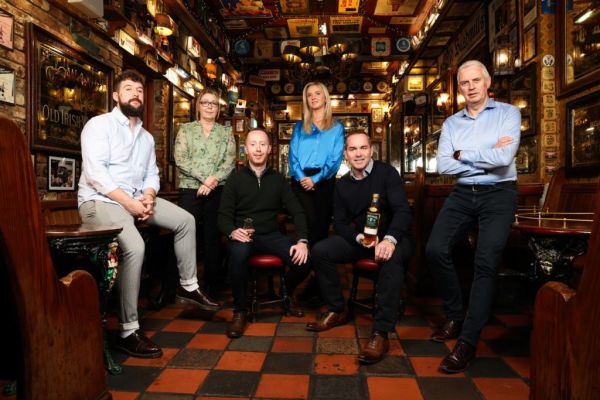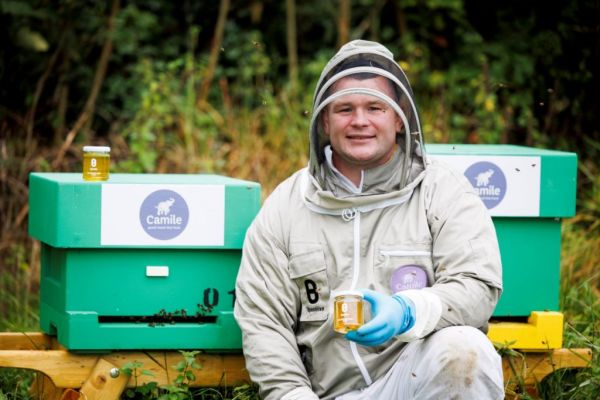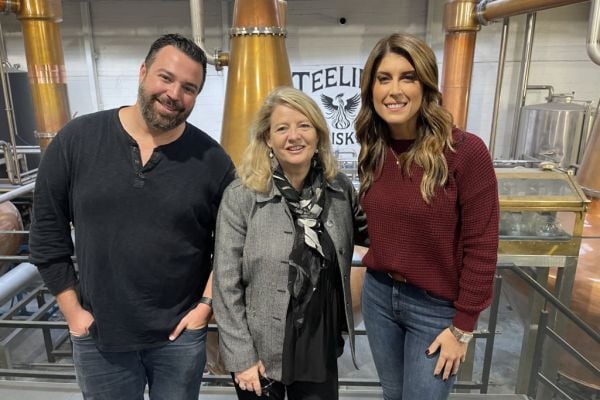Hospitality Ireland presents a round-up of the latest global food and drinks news.
Wake Up And Smell The Coffee...Made In The United States
Farmer David Armstrong recently finished planting what is likely the most challenging crop his family has ever cultivated since his ancestors started farming in 1865 - 20,000 coffee trees.
Except Armstrong is not in the tropics of Central America - he is in Ventura, California, just 60 miles (97 km) away from downtown Los Angeles.
"I guess now I can say I am a coffee farmer!" he said, after planting the last seedlings of high-quality varieties of arabica coffee long cultivated in sweltering equatorial climates.
Coffee is largely produced in the Coffee Belt, located between the Tropic of Cancer and the Tropic of Capricorn, where countries such as Brazil, Colombia, Ethiopia and Vietnam have provided the best climate for coffee trees, which need constant heat to survive.
Climate change is altering temperatures around the globe. That is harming crops in numerous locales, but opening up possibilities in other regions. That includes California and Florida, where farmers and researchers are looking at growing coffee.
Armstrong recently joined a group of farmers taking part in the largest-ever coffee growing endeavour in the United States. The nation is the world's largest consumer of the beverage but produces just 0.01% of the global coffee crop - and that was all in Hawaii, one of only two US states with a tropical climate, along with southern Florida.
Traditional producers of coffee such as Colombia, Brazil and Vietnam have suffered from the impact of extreme heat and changing rain patterns. Botanists and researchers are looking to plant hardier crop varieties for some of those nations' coffee growing regions.
Top producer Brazil is going through the worst drought in over 90 years. That was compounded by a series of unexpected frosts, which damaged about 10% of the trees, hurting coffee production this year and next.
"We are getting to 100,000 trees," said Jay Ruskey, founder and chief executive of Frinj Coffee, a company that offers farmers interested in coffee growing a partnership package including seedlings, post-harvest processing and marketing.
Ruskey says that he started trial planting of coffee in California many years ago but told few about it. He said that he only "came out of the closet as a coffee farmer" in 2014, when Coffee Review, a publication that evaluates the best coffees every crop year, reviewed his coffee, giving his batch of caturra arabica coffee a score of 91 points out of 100.
Frinj is still a small coffee company targeting high-end specialty buyers. Frinj sells bags of five ounces (140 grams) for $80 each on its website. As a comparison, eight-ounce packages of Starbucks Reserve, the top-quality coffee sold by the US chain , sell for $35 each. Frinj produced 2,000 pounds (907 kg) of dry coffee this year from eight farms.
"We are still young, still growing in terms of farms, post-harvest capabilities," said Ruskey. "We are trying to keep the price high, and we are selling everything we produce." The venture is already profitable," he said.
The company has been growing slowly since, with Armstrong's 7,000-acre (2,833-hectare) Smith Hobson Ranch one of the latest, and largest, to partner with Ruskey.
"I have no experience in coffee," said Armstrong, who typically grows citrus fruits and avocados, among other crops.
To boost his chances of success, he installed a new irrigation system to increase water use efficiency and has planted the trees away from parts of the ranch that have been hit by frosts in the past.
Coffee uses 20% less water than most fruit and nut trees, according to the United Nations Food and Agriculture Organization. Water has become scarce in California after recent droughts and forest fires. Many farmers are switching crops to deal with limits on water use.
Giacomo Celi, sustainability director at Mercon Coffee Group, one of the world's largest traders of green coffee, said the risks of cultivating coffee in new areas are high.
"It seems more logical to invest in new coffee varieties that could be grown in the same current geographies," he said.
As the climate warms in the southern United States, researchers at the University of Florida (UF) are working with a pilot plantation to see if trees will survive in that state.
Scientists have just moved seedlings of arabica coffee trees grown in a greenhouse to the open, where they will be exposed to the elements, creating the risk that plants could be killed by the cold when the winter comes.
"It is going to be the first time they will be tested," said Diane Rowland, a lead researcher on the project.
Rowland said researchers are planting coffee trees close to citrus, an intercropping technique used in other parts of the world as larger trees help hold winds and provide shade to coffee trees.
The project, however, is about more than just coffee cultivation. Alina Zare, an artificial intelligence researcher at UF's College of Engineering, said scientists are also trying to improve how to study plants' root systems. That, in turn, could help in the selection of optimal coffee varieties for the region in the future.
According to the National Oceanic and Atmospheric Administration, the U.S. weather agency, annual mean temperatures were at least 2 degrees Fahrenheit (1.1 degrees Celsius) above average for more than half the time in the long-term measuring stations across the United States' southeastern region in 2020.
Florida experienced record heat last year, with average temperatures of 28.3 C (83 F) in July, and 16.4 C (61.6 F) in January. That is hotter than Brazil's Varginha area in Minas Gerais state, the largest coffee-producing region in the world, which averages 22.1 C (71.8 F) in its hottest month and 16.6 C (61.9 F) in the coldest.
"With climate change, we know many areas in the world will have difficulties growing coffee because it is going to be too hot, so Florida could be an option," Rowland said.
Candles Save France's Grand Cru Chablis From Frost Ravages
As harvest gets underway, winemaker Laurent Pinson looks at one of his top range grand cru vineyards with relief: by burning large "candles" he protected the vines from sharp spring frosts that ravaged other parts of his estate.
Still, lower overall production will force him to lift prices of his Chablis bottles, most of which go for export.
Wine production is expected to be historically low in France this year after frost and mildew fungus attacks ravaged vineyards across the country. In the Yonne region, which hosts Chablis, famous for its delicate white wines, two thirds of the harvest was destroyed, the farm ministry said.
"All the grand cru [wines] were more spared than the others because of the protections," said Pinson, who manages the more than 400-year-old wine house. "But on some plots that were completely frozen damage can reach 80%-90%," he said.
Temperatures plunged as low as -5°C (23°F) in April in wine regions including Chablis in Burgundy, hurting shoots already well-developed because of earlier mild weather.
To limit damage, winemakers including Pinson had put hundreds of candles -- cans of paraffin - among the vines to ward off the cold. The result was a deep orange glow from tens of thousands of candles in the early hours.
Other protections included wind towers and water spraying to create an ice layer around buds.
Losses in production will force Pinson to lift his prices of the 2021 Chablis vintage, he said, while overseeing grape picking.
"This will have important consequences both in terms of volumes but also in terms of prices because the markets are a little tight," he said referring to strong export demand in the past year.
Chablis, located in the northern part of the Burgundy region, produces its fruity, acidic white wine from Chardonnay grapes. Over 70% of the output is exported with key markets in Asia, northern Europe and the United States.
"We know very well that when there is a significant spike in prices the market tends to slow down, but economically increases are inevitable," Pinson said.
Britain Tells Its Food Industry To Prepare For CO2 Price Shock
Britain has warned its food producers to prepare for a 400% rise in carbon dioxide prices after extending emergency state support to avert a shortage of poultry and meat triggered by soaring costs of wholesale natural gas.
Natural gas prices have spiked this year as economies reopened from COVID-19 lockdowns and high demand for liquefied natural gas in Asia pushed down supplies to Europe, sending shockwaves through industries reliant on the energy source.
Carbon dioxide (CO2) is a by-product of the fertilizer industry - Britain's main source of CO2 - where natural gas is the biggest input cost. Industrial gas companies, including Linde, Air Liquide and Air Products and Chemicals, get their CO2 mainly from fertilizer plants.
The natural gas price surge has forced some fertilizer plants to shut in recent weeks, leading to a shortage of CO2 used to put the fizz into beer and sodas and stun poultry and pigs before slaughter.
As CO2 stocks dwindled, Britain struck a deal with US company CF Industries, which supplies some 60% of Britain's CO2, to restart production at two plants which were shut because they had become unprofitable due to the gas price rise.
"We need the market to adjust, the food industry knows there's going to be a sharp rise in the cost of carbon dioxide," Environment Secretary George Eustice told Sky News.
It would have to accept that the price of CO2 would rise sharply, to approximately £1,000 a tonne from £200 a tonne, Eustice said, adding, "So a big, sharp rise."
The three-week support for CF would cost "many millions, possibly tens of millions but it's to underpin some of those fixed costs," Eustice said.
A spokesperson for Prime Minister Boris Johnson said the government was giving CF the difference between its total production costs and what it receives from the sale of CO2.
Business Secretary Kwasi Kwarteng, who also serves as energy minister, told lawmakers he was confident the country could also secure other sources of the gas.
It was not immediately clear how the state intervention by one of Europe's most traditionally laissez-faire governments would affect the price of fertiliser - another key cost for food producers - and whether or not it would stoke demands from other energy-heavy industries for similar state support.
Ministers, including Johnson, have repeatedly brushed aside suggestions there could be shortages of traditional Christmas fare such as roast turkey, though some suppliers have warned of them.
Kwarteng has said there would be no return to the 1970s when Britain was plagued by power cuts that made the economy the "sick man of Europe", with three-day working weeks and people unable to heat their homes.
Eustice said that without the deal some of Britain's meat and poultry processors would have run out of CO2 within days.
"We know that if we did not act, then by this weekend or certainly by the early part of next week, some of the poultry processing plants would need to close," he added.
He said that the impact on food prices would be negligible.
But the boss of supermarket Iceland said the temporary arrangement would not solve the food industry's problems.
"A three week deal won’t save Christmas," managing director Richard Walker said. "And certainly won’t resolve the issue in the long term."
The British Poultry Council welcomed the deal but said the industry was still facing huge pressures from labour shortages and estimated Christmas turkey production will be down by 20% this year.
Similarly the British Meat Processors Association expressed "huge relief".
"We are focused on re-establishing (CO2) supplies before Friday this week which is when around 25% of pork production was in danger of shutting down," it said.
Britain's Food and Drink Federation said there will still be shortages of some products though they will not be as bad as previously feared, while the British Soft Drinks Association warned it would take up to two weeks before production from CF made any positive impact on market conditions.
Marks & Spencer, which typically sells one in four fresh turkeys consumed in the United Kingdom at Christmas, struck a more optimistic note, saying it was confident of full supply.
Britain's opposition Labour party said the government needed to explain the contingency plans in place in case the C02 issues are not resolved in three weeks.
Why Record High British Natgas Prices Caused A Crisis Over CO2 Supplies
Britain has warned its food producers to prepare for a 400% rise in carbon dioxide prices after paying tens of million of pounds to get CF Fertilisers to restart production in a deal that will last for three weeks.
The deal buys Britain some time to secure suppliers from other sources as it seeks to prevent the shutdown on production of a wide range of food and drinks.
WHY IS CARBON DIOXIDE IMPORTANT?
The food and drink industry is the largest user of carbon dioxide with the gas used in a wide range of beverages including beer and soft drinks.
In the meat sector, it is also used to stun animals prior to slaughter while bakers often use it in a packaging process which prolongs the life of products such as crumpets and cakes.
The gas has many other applications outside of food and drink including in medicine where it is used during a wide range of procedures from non-invasive surgery to the removal of warts.
The energy sector is also an important consumer with the nuclear industry, for example, using it as a coolant.
HOW IT IS PRODUCED?
Carbon dioxide is a by-product in the production of some fertilisers and biofuels.
In Britain, the largest sources include US company CF Fertilisers' plant in Billingham in northeast England and the company's Ince plant in north-west England.
HOW IT IS TRADED?
Fertiliser producers sell carbon dioxide to industrial gas companies such as Linde and Air Liquide who purify it to the required standard before selling it to consumers.
Carbon dioxide is sold through a mixture of contracts and spot sales.
WHY IS THERE A SHORTAGE?
CF Fertilisers halted production at its two British fertiliser plants last week due to soaring prices of natural gas, a key input in the production process.
British wholesale gas benchmark prices have more than tripled this year to record highs due to several factors including low inventory levels, strong demand in Asia, making it difficult to get liquefied natural gas shipments and maintenance issues.
This effectively removed a large chunk of supply from the market and there have been reports that carbon dioxide suppliers were not scheduling beyond 24 hours in advance.
Many consumers only have sufficient reserves of the gas to last a few days and this created fears that production of a wide range of products could be quickly brought to a halt.
CAN IMPORTS FILL THE SUPPLY GAP?
Britain does import carbon dioxide from Norway and the Netherlands but supply from these sources appears uncertain. Norway's Yara announced last week it was curtailing fertiliser production following the rise in natural gas prices while available supplies from the Netherlands may remain within the European Union as the shortage of carbon dioxide spreads across the continent.
WILL FOOD AND DRINK PRICES RISE?
Carbon dioxide accounts for only a small proportion of the overall cost of producing food and drink so a rise in its cost is unlikely to lead to a significant jump in prices.
However, the rise in energy prices which led to the shortage of carbon dioxide is likely to stoke inflation as it makes it more expensive to grow, process and transport food and drink.
News by Reuters, edited by Hospitality Ireland. Click subscribe to sign up for the Hospitality Ireland print edition.









